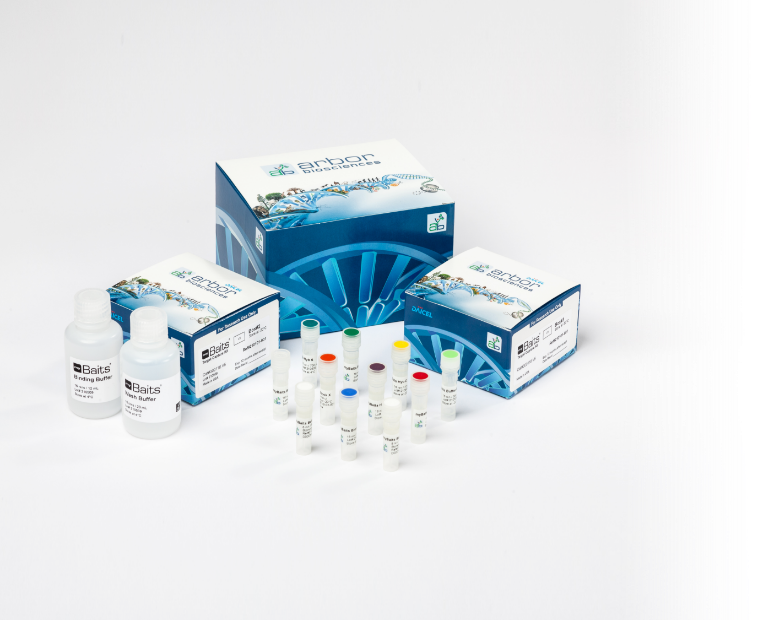Overview
Many researchers working in metagenomics, gene expression, functional genomics, evolutionary biology, and other fields have relied on myBaits® Custom kits to enhance the efficiency of their bacterial and viral targeted NGS research. myBaits kits have been used for genome sequencing, gene family sequencing, metagenomics, and gene expression studies on pathogenic, commensal, and environmental strains, from fresh samples as well as highly degraded ancient specimens such as archaeological remains. myBaits have been used for similarly diverse applications for viruses, including for discovery, surveillance, and evolutionary biology applications.
Daicel Arbor is your source for myBaits Custom panels designed by researchers and available to support your microbial and metagenomic research.
Have a suggestion to add a new panel to our list? Contact us today.
Bacteria
Resistome – Antimicrobial Resistance Genes (ARG) enrichment panel
In Guitor et al. (2019), researchers introduced a novel myBaits NGS hybridization capture panel targeting the “resistome” of antimicrobial resistance genes (ARGs), and favorably evaluated the panel’s performance for both control mock community samples as well as biological samples. This myBaits panel was demonstrated to be an effective discovery tool not only enabling comprehensive ARG profiling but also detecting novel content at considerably lower read depths compared to shotgun sequencing. Learn more at https://card.mcmaster.ca/.
Reference: Guitor, A.K., A.R. Raphenya, J. Klunk, M. Kuch, B. Alcock, M.G. Surette, A.G. McArthur, H.N. Poinar, G.D. Wright. (2019). Capturing the Resistome: a Targeted Capture Method To Reveal Antibiotic Resistance Determinants in Metagenomes. Antimicrobial Agents and Chemotherapy 64(1): e01324-19
Design ID: D10024agAMR
AMR-Cap - Antimicrobial Resistance Gene enrichment panel
In Beaudry et al. (2021), researchers introduced a novel myBaits NGS target enrichment panel “AMR-Cap” targeting antimicrobial resistance genes (ARGs) and pathogenicity islands, designed to enrich these targets from complex environmental DNA sources. This myBaits panel was demonstrated to be an effective discovery tool in mock and real complex samples, with >200-fold enrichment increase in the amount of target regions versus shotgun sequencing.
Reference: Beaudry, M.S., J.C. Thomas, R.P. Baptista, A.H. Sullivan, W. Norfolk, A. Devault, J. Enk, T.J. Kieran, O.E. Rhodes, Jr., K.A. Perry-Dow, L.J. Rose, N.J. Bayona-Vásquez, A. Oladeinde, E.K. Lipp, S. Sanchez, T.C. Glenn. (2021). Escaping the fate of Sisyphus: assessing resistome hybridization baits for antimicrobial resistance gene capture. Environmental Microbiology, 23: 7523-7537
Design ID: D10091Rsstm
Viruses
ASFV – African Swine Fever Virus
Full genome enrichment panel for ASFV designed from Georgia 2007/1 (FR682468.1) and Ken06.bus (KM111295) genome reference sequences, suitable for enriched even degraded DNA samples. This panel was used in Forth et al. (2019) for ASFV genome enrichment directly from NGS libraries built from infected organ tissue samples, enabling construction of high-coverage genome sequence, which was not possible to do with shotgun sequencing alone due to very low viral levels.
Reference: Forth, J.H., L.F. Forth, J. King, O. Groza, A. Hübner, A.S. Olesen, D. Höper, L.K. Dixon, C.L. Netherton, T.B. Rasmussen, S. Blome, A. Pohlmann, M. Beer. (2019). A Deep-Sequencing Workflow for the Fast and Efficient Generation of High-Quality African Swine Fever Virus Whole-Genome Sequences. Viruses. 2019; 11(9):846
Design ID: D10228ASFV1
HBV – Hepatitis B
Full genome enrichment panel for HBV designed from 5,230 diverse reference genome sequences covering all major viral subtyptes, demonstrated suitable for enriching even degraded ancient samples. This panel was used in Ross et al. (2018) for nearly complete genome reconstruction of a 16th century HBV strain from an ancient mummy.
Reference: Ross, Z.P., J. Klunk, G. Fornaciari, V. Giuffra, S. Duchêne, A.T. Duggan, D. Poinar, M.W. Douglas, J-S. Eden, E.C. Holmes, H.N. Poinar. (2018). The paradox of HBV evolution as revealed from a 16th century mummy. PLOS Pathogens 14(1): e1006750
Design ID: D10186hpHBV
HSV-1 and HSV-2 – Herpesvirus
Genome enrichment panel designing for herpesvirus HSV-1 and HSV-2.
Reference: Shipley, M.M., M.M. Rathbun, M.L. Szpara. (2020). Oligonucleotide Enrichment of HSV-1 Genomic DNA from Clinical Specimens for Use in High-Throughput Sequencing. Herpes Simplex Virus – Methods in Molecular Biology Book Series.
Design ID: D10229HSV12
Note about attribution: If you use one of these Community Panels (in full or modified form) in your research, please ensure that you properly cite the appropriate publication(s) in any resulting manuscripts. Where applicable, we have indicated the most appropriate current reference(s) that should be cited for each panel.
myBaits kits are for research use only and are not validated for diagnostic or therapeutic purposes.
Publications
The featured publications below correspond to our current collection of Community Panels. Daicel Arbor Biosciences thanks these authors for sharing their probe designs for the benefit of the wider research community. For more published papers that utilize myBaits Custom and Expert kits, please visit our Publications page.
Environmental Microbiology | December 1, 2021
BioTechniques | December 1, 2020
Comparison of target enrichment strategies for ancient pathogen DNA
Scientific Reports | February 13, 2020
Herpes Simplex Virus | January 1, 2020
Antimicrobial Agents and Chemotherapy | October 14, 2019
Emerging Microbes & Infections | December 1, 2018
PLOS Pathogens | January 4, 2018
The paradox of HBV evolution as revealed from a 16th century mummy
Note about attribution: If you use one of these Community Panels (in full or modified form) in your research, please ensure that you properly cite the appropriate publication(s) in any resulting manuscripts. Where applicable, we have indicated the most appropriate current reference(s) that should be cited for each panel.
myBaits kits are for research use only and are not validated for diagnostic or therapeutic purposes.
Resources
myBaits kits are for research use only and are not validated for diagnostic or therapeutic purposes.



 Bluesky
Bluesky